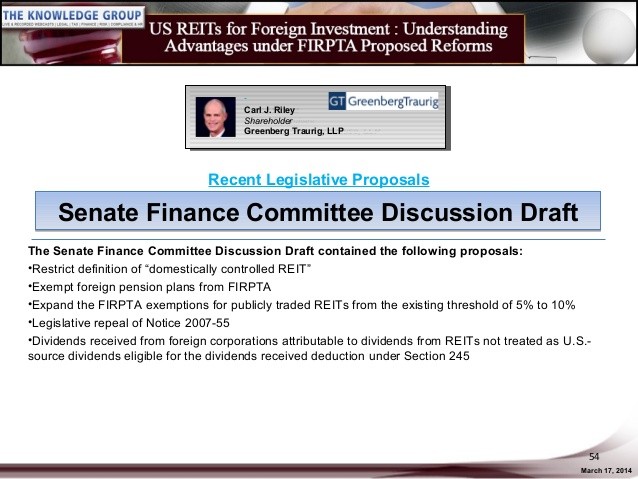Definitions of Terms and Procedures Unique to FIRPTA
Post on: 24 Июль, 2015 No Comment

Dispositions
The disposition of a U.S. real property interest by a foreign person (the transferor) is subject to income tax withholding (IRC section 1445). The transferee is the withholding agent. If you are the transferee, you must find out if the transferor is a foreign person. If the transferor is a foreign person and you fail to withhold, you may be held liable for the tax.
Normally the sale/purchase of real estate qualifies as a disposition however many other transactions also qualify as dispositions (e.g. gifts, redemptions, capital contributions, etc.).
Withholding is required on certain distributions and other transactions by domestic or foreign corporations, partnerships, trusts, and estates.
Corporations
A foreign corporation that distributes a U.S. real property interest must withhold a tax equal to 35% of the gain it recognizes on the distribution to its shareholders. However, this withholding requirement does not apply if the foreign corporation has elected under IRC section 897(i) to be treated as a domestic corporation.
A domestic corporation must withhold a tax equal to 10% of the fair market value of the property distributed to a foreign person if:
- The shareholder’s interest in the corporation is a U.S. real property interest, and
- The property distributed is either in redemption of stock or in liquidation of the corporation.
U.S. real property holding corporations. A distribution from a domestic corporation that is a U.S. real property holding corporation (USRPHC) is generally subject to NRA withholding and withholding under the U.S. real property interest provisions. This also applies to a corporation that was a USRPHC at any time during the shorter of the period during which the U.S. real property interest was held, or the 5-year period ending on the date of disposition. A USRPHC can satisfy both withholding provisions if it withholds under one of the following procedures.
- Apply NRA Withholding on Forms 1042/1042-S on the full amount of the distribution, whether or not any portion of the distribution represents a return of basis or capital gain. If a reduced tax rate applies under an income tax treaty, then the rate of withholding must not be less than 10%, unless the treaty specifies a lower rate for distributions from a USRPHC.
- Apply NRA Withholding on Forms 1042/1042-S to the portion of the distribution that the USRPHC estimates is a dividend. Then, withhold 10% on the remainder of the distribution (or on a smaller amount if a withholding certificate is obtained and the amount of the distribution that is a return of capital is established).
The same procedure must be used for all distributions made during the year. A different procedure may be used each year.
Partnerships
If a domestic partnership that is not publicly traded disposes of a U.S. real property interest at a gain, the gain is treated as effectively connected income and is subject to the rules explained under Partnership Withholding on Effectively Connected Income. and would not be subject to withholding under the FIRPTA provisions.
A publicly traded partnership that disposes of a U.S. real property interest must withhold tax on distributions to foreign partners, unless it elects to withhold based on effectively connected taxable income allocable to foreign partners as discussed under Publicly Traded Partnerships .
Trust and Estates
You are a Withholding Agent if you are a trustee, fiduciary, or executor of a trust or estate having one or more foreign beneficiaries. You must establish a U.S. real property interest account. You enter in the account all gains and losses realized during the taxable year of the trust or estate from dispositions of U.S. real property interests. You must withhold 35% on any distribution to a foreign beneficiary that is attributable to the balance in the real property interest account on the day of the distribution. A distribution from a trust or estate to a beneficiary (foreign or domestic) will be treated as attributable first to any balance in the U.S. real property interest account and then to other amounts.
A trust with more than 100 beneficiaries may elect to withhold from each distribution 35% of the amount attributable to the foreign beneficiary’s proportionate share of the current balance of the trust’s real property interest account. This election does not apply to publicly traded trusts or real estate investment trusts (REITs). For more information about this election, refer to section 1.1445-5(c) of the regulations.
Publicly traded trusts and REITs must withhold on distributions of U.S. real property interests to foreign persons. The withholding rate is 35%. For more information, including how to compute the amount subject to withholding, refer to section 1.1445-8 of the regulations. Refer to Notice 2007-55 for guidance to clarify the treatment of certain distributions by REITS to foreign governments.
Generally, any distribution from a qualified investment entity attributable to gain from the sale or exchange of a U.S. real property interest is treated as such gain by the nonresident alien individual or foreign corporation receiving the distribution. For tax years beginning after October 22, 2004, any distribution by a REIT on stock regularly traded on a securities market in the United States is not treated as gain from the sale or exchange of a U. S. real property interest if the shareholder did not own more than 5% of that stock at any time during the REIT’s tax year. These distributions are included in the shareholder’s gross income as a dividend from the REIT, not as long-term capital gain.

U.S. Real Property Interest
The term U.S. Real Property interest means an interest in real property (including an interest in a mine, well, or other natural deposit) located in the United States or the U.S. Virgin Islands, as well as certain personal property that is associated with the use of real property (such as farming machinery). It also means any interest, other than as a creditor, in any domestic corporation unless it is established that the corporation was at no time a U.S. real property holding corporation during the shorter of the period during which the interest was held, or the 5-year period ending on the date of disposition. If on the date of disposition, the corporation did not hold any U.S. real property interests, and all the interests held at any time during the shorter of the applicable periods were disposed of in transactions in which the full amount of any gain was recognized, then an interest in the corporation is not a U.S. real property interest.
After December 31, 2004, the sale of an interest in a domestically controlled qualified investment entity is not the sale of a U.S. real property interest. A qualified investment entity is any real estate investment trust (REIT) or any regulated investment company (RIC). The entity is domestically controlled if at all times during the testing period less than 50% in value of its stock was held, directly or indirectly, by foreign persons. The testing period is the shorter of (a) the 5-year period ending on the date of the disposition, or (b) the period during which the entity was in existence.
Foreign Person
A Foreign Person is a nonresident alien individual, foreign corporation that has not made an election under section 897(i) of the Internal Revenue Code to be treated as a domestic corporation, foreign partnership, foreign trust, or foreign estate. It does not include a resident alien individual.
Transferor
The term Transferor means any foreign person that disposes of a U.S. real property interest by sale, exchange, gift, or any other transfer. A transfer includes distributions to shareholders of a corporation, partners of a partnership, and beneficiaries of a trust or estate.
The owner of a disregarded entity is treated as the transferor of the property, not the entity.
Transferee
The term Transferee means any person, foreign or domestic, that acquires a U.S. real property interest by purchase, exchange, gift, or any other transfer.
Amount Realized
The Amount Realized by the transferor is the sum of:
- The cash paid, or to be paid (principal only),
- The fair market value of other property transferred, or to be transferred, and
- The amount of any liability assumed by the transferee or to which the property is subject immediately before and after the transfer.
U.S. Real Property Holding Corporation (USRPHC)
In general, a corporation is a U.S. real property holding corporation if the fair market value of the U.S. real property interests held by the corporation on any applicable determination date equals or exceeds 50 percent of the sum of the fair market values of its -
- U.S. real property interests,
- Interests in real property located outside the United States, and
- Certain business assets.
Refer to Treasury Regulation 1.897-2, United States real property holding corporations.
References/Related Topics
Note: This page contains one or more references to the Internal Revenue Code (IRC), Treasury Regulations, court cases, or other official tax guidance. References to these legal authorities are included for the convenience of those who would like to read the technical reference material. To access the applicable IRC sections, Treasury Regulations, or other official tax guidance, visit the Tax Code, Regulations, and Official Guidance page. To access any Tax Court case opinions issued after September 24, 1995, visit the Opinions Search page of the United States Tax Court.














